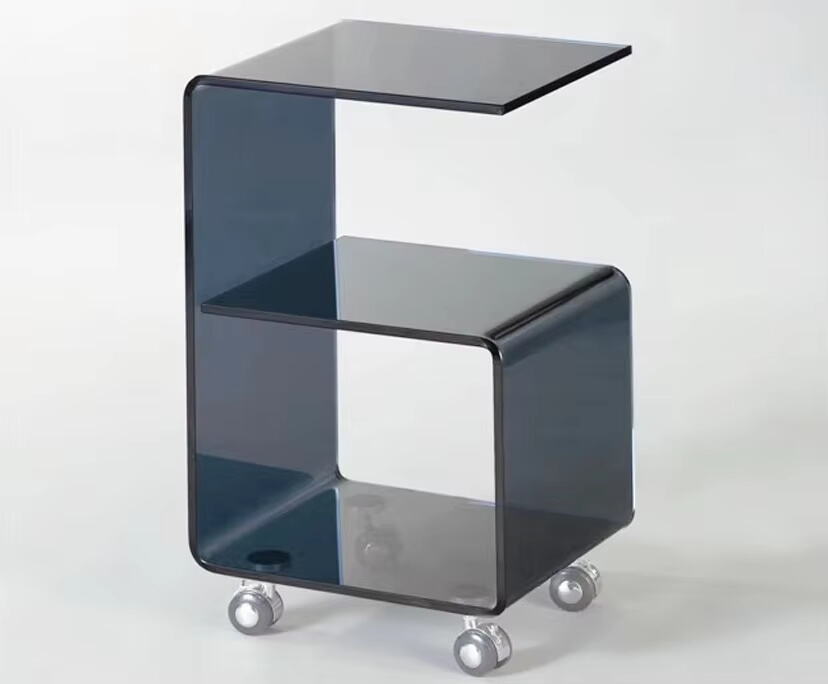Definice zakřiveného skla a jeho designová revoluce
Výrobní proces vzniku zakřiveného skla
Výroba zakřivené sklo začíná výběrem správných materiálů, obvykle float skla, protože má ten krystalicky čistý vzhled, který si každý přeje. Při výrobě zakřiveného skla nejprve materiál zahřívají, dokud není dostatečně měkký na zpracování, a poté jej ohnou do požadovaného tvaru. Moderní továrny výrazně spoléhají na technologie, jako jsou pece řízené počítačem, aby byly zakřivení přesně podle potřeby. Velkou roli hraje také teplo. Technici během procesu ohýbání používají speciální formy a různé nástroje, aby sklo uchovalo svou pevnost a zároveň bylo správně tvarováno. Po tvarování následuje kontrola kvality. Provádějí se testy, které měří tloušťku skla v různých bodech, zkouší se odolnost vůči působení tlaku a ověřuje se, zda sklo vydrží změny teploty bez prasknutí. Všechny tyto kroky pomáhají zajistit, že hotový výrobek bude odpovídající průmyslovým normám. Celý proces ukazuje, proč zůstává izolační zakřivené sklo i v dnešním trhu produktem vyšší kategorie.
Historický vývoj v architektonickém návrhu
Zakřivené sklo v architektuře si dlouhou dobu uplatnilo své místo poté, co poprvé upoutalo pozornost lidí svým neobvyklým vzhledem v raných letech 20. století. Stačí pomyslet na památné stavby jako je Time Warner Center hrdě se tyčící v New Yorku nebo působivá skleněná pyramida v Louvru v Paříži – tyto budovy skvěle ukazují, co vše dokáže zakřivené sklo, pokud jde o estetiku i funkčnost. S postupem technologie v průběhu různých období začali architekti více experimentovat s tímto materiálem. Dnešní nástroje pro počítačové modelování umožňují návrhářům vypočítat všechno down do posledního detailu a zároveň zpřístupnit chytré skleněné varianty, které jsou dnes cenově dostupnější než kdy dříve. Tento trend vidíme dnes všude – od kancelářských věží po muzea – kde zakřivené sklo již není pouze dekorativním prvkem, ale mění způsob, jakým prostory fungují. Posun, který se v posledních desetiletích v architektuře odehrál, přesně dokazuje, jak technologie neustále mění tvář našich měst po celém světě.
Estetické výhody zakřiveného skla
Tvorbа plynulých architektonických forem
Když architekti používají zakřivené sklo, budovy začínají méně připomínat krabice a více tekoucí vodu nebo přírodní krajiny, na rozdíl od těch rovných hranatých krabic, které vidíme všude kolem. Tento materiál umožňuje designérům experimentovat s nejrůznějšími zajímavými tvary a křivkami, které se docela dobře hodí k okolnímu prostředí. Vezměme si například Louvre Abu Dhabi – ty nádherné kopule umožněné zakřiveným sklem vytvářejí něco zcela zvláštního z hlediska vzhledu. Lidé procházející tímto prostorem pravděpodobně mají jiný pocit než uvnitř běžné budovy. Je prostě něco v prostorách vytvořených tímto způsobem, co lidem umožňuje cítit se uvolněněji a propojeněji se svým okolím, místo aby byli uvězněni v nějakém chladném, bezduchém prostředí.
Zvyšování vizuální kontinuity v interiérech
Pokud jde o návrh interiéru, zakřivené sklo je ve skutečnosti docela úžasné v tom, že prostory vnímáme jako propojené, nikoli oddělené. Designéři rádi využívají právě tato zakřivená skla a příčky, protože se tím zbavíme ostrých rohů, které působí osamoceně. Jaký je efekt? Prostory se mnohem lépe prolínají. Navíc všechno to zakřivené sklo propouští mnohem více denního světla, čímž se místnosti jeví větší, než ve skutečnosti jsou. Tento efekt dokonce potvrzují i výzkumy – lidé se obecně cítí šťastnější a pohodověji, když do místnosti proudí dostatek denního světla. A nesmíme zapomenout ani na dekorativní možnosti. Zakřivené sklo nabízí bezpočet kreativních možností, jak přidat styl, a zároveň zachovat funkčnost. Od uměleckých instalací až po jemné akcenty – tyto povrchy proměňují běžné interiéry v něco výjimečného, aniž by byla obětována praktičnost.
Designové úpravy interiéru se skleněnými zábradlími
Zakřivená skleněná zábradlí mění pravidla hry, pokud jde o interiérové prostory. Poskytují bezpečnost, aniž by omezovala výhled ven. Celá myšlenka spočívá v návrzích, kde převažují průhledné materiály nad klasickými zdmi a ploty. Denní světlo těmito konstrukcemi volně proudí, přesto zůstávají lidé chráněni před nebezpečím pádu. Podívejte se na nedávné stavební projekty po městě – mnohé z nich začaly používat zakřivená skleněná zábradlí v halech a chodbách, protože opravdu mění způsob, jakým lidé vnímají prostor. Samozřejmě vyžaduje sklo v prostorách s intenzivním provozem zvláštní pozornost, kde celý den chodí mnoho lidí. V současnosti však existují speciální úpravy, které pomáhají chránit sklo před poškrábáním a nárazy. Výrobci také vyvinuli způsoby, jak sklo zesílit, aby vydrželo déle. To vše znamená, že zakřivená skleněná zábradlí jsou vhodná nejen pro estetický vzhled, ale také pro odolnost vůči běžnému opotřebení.
Funkční výhody designu v moderních prostorech
Optimalizované rozložení denního světla
Zakřivené sklo hraje důležitou roli při zajištění většího množství denního světla uvnitř moderních budov, což znamená, že již není zapotřebí tolik umělého osvětlení. Pokud je správně nainstalováno, tyto hladké zakřivené plochy umožňují proniknutí denního světla hlouběji do místností a pracovních prostor, čímž vytvářejí příjemnější a světlejší prostředí. Výzkumy ukazují, že lidé jsou produktivnější, pokud mají k dispozici dostatek přirozeného světla, a navíc se obecně zlepšuje jejich náladová dispozice. V průběhu času budovy využívající zakřivené sklo ušetří peníze na elektřině, protože během dne méně závisí na umělém osvětlení. Architekti začínají považovat tuto skutečnost za výhodnou jak pro bytové, tak kancelářské budovy.
Bezešvé přechody mezi interiérem a exteriérem
Zakřivené sklo umožňuje hladké přechody jak vizuálně, tak fyzicky mezi tím, co je uvnitř prostoru a co je mimo něj, čímž výrazně zlepšuje, jak lidé zažívají své životní prostředí. Mnoho současných designových trendů se zaměřuje na slévání venkovní krajiny s interiérovými prostory a zde se zakřivené sklo ukazuje jako výjimečně vhodné pro dosažení takové rovnováhy. Když se mluví o architektuře a interiérovém designu, odborníci trvale zdůrazňují, jak důležité jsou právě tyto přechody. Vysvětlují, jak pomáhají vytvářet prostředí, ve kterém se lidé skutečně cítí spojeni s přírodou, nikoli odděleni od ní. Podívejte se na nedávné stavební projekty a uvidíte, že zakřivené sklo zajišťuje přesně tento účel – umožňuje nepřetržené, souvislé výhledy, které dnes ve světě moderní architektury činí obrovský rozdíl.
Akustický výkon v návrhu rezidenčních objektů
Zakřivené sklo dělá něco docela chytrého, pokud jde o potlačení hluku, což vysvětluje, proč ho dnes používá tolik moderních domácností. Způsob, jakým sklo ohýbá zvukové vlny, ve skutečnosti pomáhá blokovat nežádoucí zvuky zvenčí a udržuje hluk z ulice a dopravy v uctivé vzdálenosti, aniž by to ubíralo na vizuální kráse rozsáhlých oken. Architekti tento efekt potvrdili na několika luxusních stavbách, kde si obyvatelé konkrétně přáli lepší řízení hluku. Majitelé domů, kteří nainstalovali zakřivené sklo, uvádějí výrazně tišší interiéry, zejména ve srovnání s tradičními rovnými skly. Ačkoli to není magické řešení pro všechny hlukové problémy, rozhodně to pomáhá vytvářet ty klidné životní prostory, po kterých dnes lidé touží.
Zahrnutí ohnutého skla do různých aspektů návrhu nejenom zvyšuje vizuální atraktivitu, ale také plní funkční účely, které významně ovlivňují moderní architekturu a rezidenční život. Jedná se o inovativní materiál, který pokračuje v transformaci prostor optimalizací distribuce světla, zajištěním hladkých přechodů a zlepšením akustické výkonnosti.
Energetická účinnost a vlastnosti udržitelnosti
Ohnuté izolační sklo pro tepelnou regulaci
Pokud jde o udržování budov teplých v zimě a chladných v létě, zakřivené izolované sklo ve skutečnosti funguje lépe než běžné rovinné skleněné panely. Díky svému tvaru dokonaleji zapadá do konstrukce budovy, což znamená méně míst, kudy může v zimním období unikat teplý vzduch nebo naopak pronikat teplo, když teploty stoupají. U budov, které toto sklo instalují, se obvykle pozoruje výrazný pokles nákladů na energie. Výzkumy z několika zdrojů naznačují snížení nákladů na vytápění a chlazení až o 20 % u staveb, které využívají zakřivené izolované sklo v celém svém návrhu. Architekti rádi s tímto materiálem pracují, protože nejenže vypadá skvěle, ale zároveň plní funkci izolace, čímž umožňuje vytvářet vizuálně atraktivní budovy, aniž by bylo třeba obětovat pohodlí nebo zvyšovat provozní náklady.
Analýza nákladů a přínosů inteligentního skla
Pohled na to, co stojí technologie chytrého skla a co ušetří, ukazuje, že rozhodně stojí za to provést záměnu, a to i přes vyšší počáteční ceny ve srovnání s běžnými skleněnými variantami. Ano, chytré sklo má vyšší pořizovací náklady, ale v průběhu času se vám sníží výdaje na energie, protože sklo lépe reguluje vnitřní teplotu budov. Některé studie ukazují, že budovy vybavené chytrým sklem sníží své roční náklady na energie přibližně o 30 procent pouhým ovládáním množství vstupujícího nebo výstupujícího tepla. Stále častěji se setkáváme s tím, že architekti zadávají chytré sklo při návrhu ekologických staveb, protože klienti si přejí budovy, které dobře fungují a zároveň jsou ekologické. Kombinace technologických vlastností a praktických výhod znamená, že se posouváme směrem k budoucnosti, kdy budovy nebudou vypadat dobře jen na papíře, ale budou i každodenně fungovat udržitelně.
Strategie řízení solárního zisku
Řízení slunečního zisku zůstává klíčové pro udržení energetické účinnosti budov s zakřiveným sklem. Specializované povrchové nátěry skla v kombinaci s vnějšími clonícími systémy pomáhají regulovat množství slunečního světla, které skutečně proniká do interiéru budovy. V praxi jsme viděli, že to funguje dobře v různých komerčních projektech, kde některé dosáhly zlepšení energetických výkonů až o 25 procent po implementaci těchto opatření. Do budoucna vývojáři a inženýři pracují na nových technologiích speciálně navržených pro aplikace zakřiveného skla. Tyto inovace pravděpodobně umožní lepší kontrolu vnitřního klimatu a sníží závislost na mechanických systémech vytápění a chlazení. Protože se standardy zelených staveb nadále vyvíjejí, stává se správné plánování od samotného začátku stále důležitějším pro maximalizaci úspor energie v moderních konstrukcích s fasádami z zakřiveného skla.
Inovace ve struktuře a bezpečnosti
Zvýšená odolnost kalením
Kalené sklo se opravdu vyčnívá, pokud jde o zvýšení odolnosti, zejména u těch zakřivených designů, které dnes vidíme všude. Při kalení skla výrobci sklo zahřívají na velmi vysokou teplotu a následně rychle ochlazují, čímž se výrazně zpevní. Jaký je výsledek? Kalené sklo vydrží přibližně pětkrát větší sílu než běžné sklo, než se rozbije. Architekti rádi používají tento materiál ve stavbách, protože přináší extra vrstvu bezpečnosti, což je zvláště patrné v nákupních centrech a kancelářských komplexech, kde se celý den pohybují lidé. I technologie výroby kaleného skla se neustále zlepšuje, takže dnes vidíme skleněné výrobky, které nejen vydrží déle, ale také lépe odolávají v podmínkách zvýšeného namáhání. Proto se na mnoha současných stavbách spoléhají na řešení s kaleným sklem namísto tradičních alternativ.
Odolnost proti nárazům v náročných prostředích
Prostudovali jsme zakřivené sklo, které si docela dobře poradí s nárazy, což z něj činí chytrou volbu pro místa jako jsou nákupní centra, školy a úřady, kde je bezpečnost lidí na prvním místě. Výrobci používají speciální povlaky a vícevrstvou konstrukci, aby zvýšili skutečnou odolnost tohoto skla. Když nastanou katastrofální události v době silného počasí nebo pokusy o vloupání do budovy, tyto vyztužené panely pomáhají snižovat zranění i náklady na opravy. Některé studie naznačují, že instalace tohoto typu bezpečnostního skla může zabránit zhruba polovině zranění, která by jinak vznikla při rozbití skla. Do budoucna architekti a odborníci na materiály pracují na ještě lepších způsobech, jak zabezpečit budovy, aniž by byla ohrožena estetika návrhu. Vidíme také některé nadšené novinky v oblasti interakce skla s jinými materiály.
Univerzálnost v architektonických aplikacích
Fasády obchodních budov
Ohýbané sklo mění způsob, jakým přemýšlíme o exteriérech komerčních budov, a pomáhá firmám vytvářet silnější firemní identity, zároveň s tím, že jejich budovy vypadají lépe. Stále více developerů se pro své projekty obrací k ohýbanému sklu, protože umožňuje větší okna a propouští velké množství denního světla. To znamená nižší náklady na energie z důvodu menší potřeby osvětlení a zároveň vytváří nádherné vizuály, které upoutají pozornost. Když architekti pracují s ohýbaným sklem, musí nejprve zkontrolovat několik věcí. Posuzují, zda konstrukce unese jeho váhu, zda sklo vydrží různé povětrnostní podmínky a jak dobře zvládá přenos tepla v průběhu ročních období. Některé opravdu působivé budovy po celém světě nyní disponují těmito ohýbanými skleněnými fasádami, což ukazuje, jak daleko tato technologie došla. Zajímavé je sledovat, jak rychle se ohýbané sklo přesunulo z fáze novinky ke standardnímu postupu v moderním komerčním designu.
Ozdobné stěny a příčky v rezidenčních prostorech
Ohýbané sklo se stalo velkým hitem v domů design v poslední době, kdy slouží zároveň jako projev stylu a praktický prvek. Pokud se použije pro výrazné stěny nebo příčky, úplně změní pocit z interiéru. Sklo, které se ohýbá kolem rohů, vytváří plynulé přechody mezi různými částmi domu a zároveň propouští spoustu denního světla. Mnoho současných domácností nyní zahrnuje tyto ohýbané skleněné části, zejména v otevřených prostorech, kde pomáhají dosáhnout iluze většího prostoru v malých místnostech. Trend směřující k průhledným materiálům právě teď nabývá na obrátkách, protože majitelé domů chtějí, aby jejich životní prostředí působilo lehce a přívětivě. Není se čemu divit, že stále více architektů zahrnuje do svých nejnovějších projektů prvky z ohýbaného skla pro klienty, kteří si přejí něco opravdu jedinečného.
Integrace automobilů a nábytku
Zakřivené sklo už není určeno jen pro budovy. Výrobci automobilů ho začali používat také, a to především proto, že zvyšuje bezpečnost vozidel a zároveň působí velmi atraktivně. Pokud mají automobily zakřivené čelní a boční okna, snižuje se u nich odpor vzduchu, řidič má lepší výhled v zatáčkách a karoserie celkově získává na pevnosti. Pro výrobce nábytku dodává zakřivené sklo výjimečnost stolním deskám i knihovnám. Způsob, jakým se světlo láme skrze tyto zakřivení, vytváří zajímavé odrazy a kromě toho působí zaoblené hrany při doteku mnohem příjemněji. Interiéroví designéři nyní rádi s tímto materiálem pracují, zejména proto, že si majitelé domů přejí prostory, které se odlišují od běžných, šablonových řešení. Díky novým výrobním technologiím, které se neustále vyvíjejí, pravděpodobně v nejbližší budoucnosti uvidíme ještě více kreativních způsobů využití zakřiveného skla – od příček v kancelářích až po venkovní sedací zóny.

Sekce Často kladené otázky
Jaká je hlavní výhoda použití ohnutého skla v architektuře?
Zakřivené sklo nabízí jedinečnou kombinaci estetického vzhledu a funkčních výhod, včetně optimalizované distribuce denního světla, energetické účinnosti a zlepšené akustické izolace.
Jak může zakřivené sklo ovlivnit interiérový design?
Zakřivené sklo zlepšuje vizuální kontinuitu, umožňuje plynulé přechody mezi prostory a zvyšuje průnik denního světla, čímž vytváří dojem prostornějšího a otevřenějšího interiéru.
Může zakřivené sklo ovlivnit úspory energie?
Ano, izolované zakřivené sklo může výrazně snížit spotřebu energie, a to až o 20 % na vytápění a chlazení.
Je zakřivené sklo dražší než tradiční sklo?
I když jsou počáteční náklady vyšší, dlouhodobé úspory díky optimalizované energetické účinnosti často činí zakřivené sklo cenově efektivní volbou.
Jak ovlivňuje 3D tisk návrhy zakřiveného skla?
3D tisk umožňuje větší personalizaci a složitější návrhy, čímž rozšiřuje možnosti použití zakřiveného skla v různých oblastech architektury a designu.


